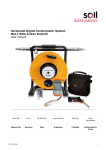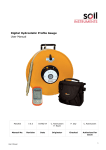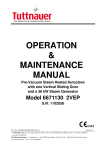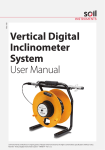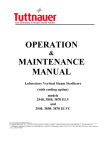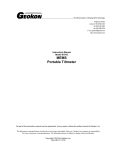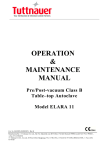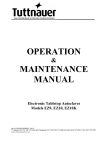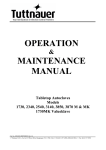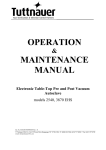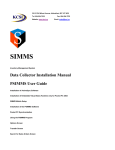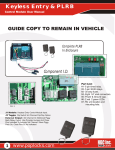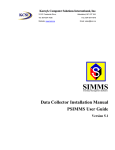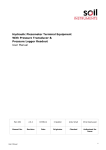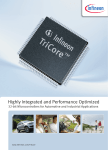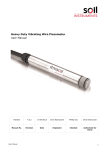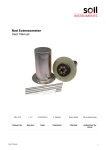Download MAN-205 Digital Portable Tiltmeter System
Transcript
Digital Portable Tiltmeter System
User Manual
Man205
5.0.2
06/08/2014
L.Williams
C Rasmussen
Phil Day
P Royle
Chris
Rasmussen
Manual
No.
Revision
Date
Originator
Checked
Authorised
for Issue
User Manual
1
Section 1 : Contents
Section 1 :
Contents ........................................................................................................................................ 2
Section 2 :
Introduction ................................................................................................................................. 3
Section 3 :
Equipment Supplied .................................................................................................................. 4
3.01
3.02
3.03
3.04
3.05
Section 4 :
4.01
4.02
4.03
4.04
4.05
4.06
4.07
Section 5 :
5.01
5.02
5.03
5.04
5.05
5.06
5.07
5.08
5.09
5.10
5.11
5.12
5.13
5.14
5.15
Section 6 :
6.01
6.02
6.03
Section 7 :
7.01
7.02
7.03
7.04
7.05
User Manual
The Tiltmeter .................................................................................................................................. 4
The Digital Readout (Field PC) and Accessories ..................................................................... 4
Remote Handheld Activator (Key Fob) ..................................................................................... 4
Specifications ................................................................................................................................. 4
Before First Use.............................................................................................................................. 4
About Tilt_Port Software ....................................................................................................... 5
Purpose ............................................................................................................................................ 5
System Requirements .................................................................................................................. 5
Interacting with the System........................................................................................................ 5
Finding your way Around: ........................................................................................................... 5
The “Virtual Keyboard” ................................................................................................................. 5
Help – I’m Lost! ............................................................................................................................. 6
Installing Tilt_Port from the Memory Card .............................................................................. 6
Tilt_Port Software ..................................................................................................................... 8
Basic Concept of Operation ......................................................................................................... 8
Setting Up Bluetooth on the Field PC ........................................................................................ 8
Admin and User Modes ................................................................................................................. 9
Starting the Program .................................................................................................................... 9
Start-up Screen ........................................................................................................................... 10
FormSet1 – Site Set-up ............................................................................................................. 10
FormSet2 – Tilt-Plate Set-up .................................................................................................... 11
To add Tilt-Plates to a Site ........................................................................................................ 11
To Amend or Delete Existing Tilt-Plates ................................................................................. 12
To Delete Sites ............................................................................................................................. 12
User Screen 1 – (FormUse1) ..................................................................................................... 12
User Screen (FormUse2) - Readings ....................................................................................... 13
Download Readings Screen ....................................................................................................... 13
Transferring Downloaded Files to a PC ................................................................................... 14
Register Key Fob .......................................................................................................................... 15
Operating Procedure .............................................................................................................. 16
Introduction & Reading Overview ............................................................................................ 16
Checking the Equipment Before Use ....................................................................................... 16
Taking Readings .......................................................................................................................... 16
Maintenance ............................................................................................................................... 19
Care and Maintenance of the Tiltmeter System.................................................................... 19
Charging the System .................................................................................................................. 19
Field PC Battery Life.................................................................................................................... 20
Calibration ..................................................................................................................................... 21
Troubleshooting ........................................................................................................................... 21
2
Section 2 : Introduction
The Soil Instruments Digital Tiltmeter System is designed and built using the very latest
technology.
The readings are acquired and displayed using the Tilt_Port Soil Instruments Field PC
based software. Bluetooth technology and the remote handheld activator (Key Fob) for
taking readings, give a complete cable free reading and data transmitting system, with no
field connectors to corrode or break.
The Tiltmeter contains the accelerometer, hard coded calibration factors, power supply and
A/D converters, the logging electronics, battery and system power supply.
DIGITAL BLUETOOTH TILTMETER KEY SYSTEM COMPONENTS
Tiltmeter
Key Fob
Field PC
Tilt-Plate (normally attached to
structure to be monitored)
User Manual
3
Section 3 : Equipment Supplied
Tiltmeter
Digital Readout (Field PC) and Accessories (shock resistant and water proof case)
Remote Handheld Activator (Key Fob)
Accessories case with accessories
3.01 The Tiltmeter
The Tiltmeter contains the tilt sensor and all of the electronics to take readings, apply
calibration factors and transmit data to the Field PC. It also contains the batteries and the
power supply for the system.
3.02 The Digital Readout (Field PC) and Accessories
The Field PC communicates to and from the Tiltmeter by means of Bluetooth technology
and so requires no leads or cables. It is supplied with a lead for downloading to a PC or
laptop via a USB connection, a charger is also supplied. The Field PC comes with Soil
Instruments Tilt_Port and Microsoft Active Sync software already installed.
3.03 Remote Handheld Activator (Key Fob)
The Key Fob comes with a sprung clip for attaching to the Field PC case or elsewhere. It
enables the user to initiate readings without having to touch the Field PC screen. If
preferred, readings can be taken using the ‘read’ button on the Field PC, the Key Fob, or a
combination of both to suit personal preference.
3.04 Specifications
Please refer to the Soil Instruments datasheet (available from Soil Instruments or www.Soil
Instruments.com ) for the current specification for the particular instrument delivered. If in
doubt please contact Soil Instruments.
3.05 Before First Use
IMPORTANT:
User Manual
If the Field PC has not been used for a prolonged period of time;
it may loose battery power. The Field PC is designed to retain
programs even if the battery is allowed to fully discharge,
however we recommend that the battery is charged on a
regular basis and that the Tiltmeter and Field PC are allowed to
fully charge before the system is first used.
4
Section 4 : About Tilt_Port Software
4.01 Purpose
Tilt_Port is a program developed by Soil Instruments to take readings from our digital
Tiltmeters. It uses Bluetooth wireless technology to communicate with the Tiltmeter,
receive the readings, perform checksums and store the results. Tilt_Port also hold details of
Tilt-Plate locations, allows for new Tilt-Plates to be set up and prompts the user through the
reading process.
4.02 System Requirements
Tilt_Port will run on any Personal Digital Assistant (Field PC), which runs the Microsoft
Pocket PC operating system, version 2003 or higher. It does not need any of the
programmable buttons on the Field PC to function, but any one of these buttons can be
programmed to start up the software – see your Field PC’s user manual for details. It has a
footprint of approximately 124Kb and uses about 3.5Mb of memory when running. In
addition, the database it uses has an initial footprint of approximately 250Kb; this will
slowly grow as readings are taken, but should never exceed 1 or 2 MB, provided readings
are regularly downloaded and deleted.
4.03 Interacting with the System
There are three user modes within the Tilt_Port software, two for controlling and entering
data into the program and one for direct communication with the Tiltmeter to take
readings. For using the program we have:
The stylus. This is situated in its holder on the back of the Field PC. Deliver a brief, firm tap
with this at the appropriate point on the screen to “press” a “button”, change the value of a
check box, etc, or to place the cursor in order to enter text. Text is entered using
The “virtual keyboard”. See section 4.05 below for more detail on this.
The Key Fob .For direct communication with the Tiltmeter there is the “Key Fob”. This is a
button-activated radio transmitter that tells the to take a reading and send the data to the
Field PC Tilt_Port software. A momentary press on the button operates the Key Fob. It does
not need to be pointed at the directly, but will work better when it is. It is not very effective
when solid objects such as walls or vehicle doors intervene.
4.04 Finding your way Around:
When the system is started for the first time, or after a soft reset of the Field PC, the
“Today” screen will be displayed. To access the Tilt_Port software, tap on the “Start” button
at the top left to drop down the Programs menu. In here you will see “Tilt_Port”. Tap this to
start the program. When a program is running, tap the same place (where the name of the
current program or form appears), or on the Windows icon in the very top left-hand corner,
to drop down the programs menu.
In the “Today” screen will be the Bluetooth icon. Tap on this and select “Turn Bluetooth
On/Off” as needed.
For other functions not specific to Tilt_Port, see the built-in help or the Field PC user
manual.
When Tilt_Port is running, actions will be selected either from buttons on screen or from
the menu bar at the bottom of each screen.
4.05 The “Virtual Keyboard”
This is a software equivalent of a keyboard. It is displayed or hidden by tapping the
keyboard icon in the bottom of the screen (this is only visible when a program is running
that can use the keyboard for input). To use it, simply tap the required key. Tap the Shift
button for a single upper-case letter or special character, or tap on CAP for continuous
entering of shifted characters. More special characters, especially accented letters, are
available by tapping the keyboard icon at the bottom of the screen.
User Manual
5
Before starting to use the virtual keyboard, ensure the cursor is positioned at the point
where you need the text to appear (by tapping that point on the screen).
4.06 Help – I’m Lost!
If the Field PC locks up, or you accidentally start up a program and don’t know how to get
out of it, there a couple of ways that you can get back to where you want to be. Tapping the
Windows icon at the top left of the screen should always bring up the Windows Start Menu.
If that is not possible, you need to carry out a “soft reset” of the Field PC. To do this, hold
down the on/off key for about 3 seconds. The unit will start to countdown from 5. Releasing
the unit during the countdown will display this menu:
Tapping “Reset” will start a reboot of the Field PC, closing any running programs, without
losing any installed programs or settings. If the button is held down for longer, be careful –
do not press any other buttons or you may trigger a “Clean boot” which will delete any userinstalled programs.
To get out of this screen without re-booting, just tap the “OK” in the top right-hand corner.
4.07 Installing Tilt_Port from the Memory Card
If the Field PC has never had Tilt_Port installed or has been 'hard reset', Compact
Framework will require installation from a PC to the Field PC. The PC must have Microsoft
ActiveSync installed. The HP installation CD can be found with the Field PC that ActiveSync
can be installed from.
Once ActiveSync is installed, connect the Field PC with the Field PC USB fly lead to the PC.
Ensure the Field PC remains on during this process. Using the ActiveSync window browse
function, go to the My Pocket PC and SD card. Copy and paste the file onto your PC. Double
click on the file to run. Follow the on screen prompts to install the software and the prompts
on the Field PC.
If ‘Compact Framework’ is already installed with your PC you will need to install/upgrade by
another method. Please contact Soil instruments for further assistance
If the Tilt_Port program is lost for any reason (in other words, does not appear in either the
“Start” menu or the “Programs” screen), it must be re-installed from the supplied memory
(Storage Card) card. Use the File Explorer program to navigate to the card, as follows:
User Manual
tap on “Programs” in the Start menu, then on “File Explorer”
from the top left-hand drop-down menu, choose “My Device”. If this is not visible,
click on the first item in the drop-down list and repeat this until “My Device” is
visible.
6
click on “Storage Card”
two programs must be installed. To install, just click on the name once, and wait
until installation is complete. The following programs must be installed, in the order
shown. If any one of them says it already exists, just say yes when asked if it is OK
to overwrite it.
1.
sqlce30.ppc.wce4.armv4.cab
2.
Tilt_port.cab
(There should be a message saying, re-installing Tilt_Port will overwrite any existing
database, so the database should be copied elsewhere before re-installing. It can be
found in the “Storage Card” folder, and is called “DB_tiltport2.sdf”.)
When prompted, install the files onto the ‘Device’ not the ‘SD’ card.
The program will now be in the “Program Files” screen, but probably not in the Start
menu, as the Field PC will have returned to its factory settings and the limit on the
number of programs in the menu will have been reached. To rectify this, Tap on Start
– Settings. On the “Personal” tab, select “Menus”. By checking and unchecking
options, you will be able to customise the Start menu.
Note: On some Field PC’s a warning may be generated when installing any of the above,
saying the program may not display correctly as it was designed for a previous
version of Windows Mobile Software. This message can be safely ignored.
IMPORTANT: Soil Instruments strongly recommend that you back up the
information from the Field PC storage card on a regular basis to
prevent loss of data and software due to accidental deletion by users.
Although the software can be re-installed, the database and
information created by users can not be recovered if accidentally
deleted.
User Manual
7
Section 5 : Tilt_Port Software
5.01 Basic Concept of Operation
Tilt_Port is the set-up and Tilt-Plate logging software for the Soil Instruments Digital
Tiltmeter. It uses Bluetooth wireless technology to take and receive readings from the
Tiltmeter, and saves those readings to a database. They can then be downloaded to a textformat file, which can then be transferred to a PC, using Microsoft’s ActiveSync software, for
later loading into analysis software. To use Tilt_Port to read an tilt plate, the site and its
location must have been defined, using the “Admin” mode. The typical model of use is:
Define the site
Define all Tilt-Plates
Take readings
Download readings for a site and, optionally, delete them
Transfer readings to PC and process using software such as Microsoft Excel
Steps (i) and (ii) are done only once for each site. Steps (iii) to (v) will be carried out each
time readings are taken, although steps (iv) and (v) can be delayed – in other words,
repeated sets of readings can be taken before downloading them.
More detailed information on these procedures will be found in the following sections.
IMPORTANT:
it is essential that the “local settings” for both Field PC and PC
are the same – ie they are both set to “English (UK)”, “English
(United States)”, “French”, etc. Also, it is not advisable to
switch the Field PC from one locale to another when readings
are in the database. Delete any existing readings before
changing local settings.
5.02 Setting Up Bluetooth on the Field PC
The Field PC and tiltmeter are shipped fully set-up and ready for use. If for some reason
Bluetooth does not start when Tilt_Port is run (the blue ‘comms ready’ light on the tiltmeter
should be illuminated), follow the procedure below to re-connect to the tiltmeter via
Bluetooth when Tilt_Port is started.
Note: Exit Tilt_Port before following these instructions
Ensure the tiltmeter and the Field PC are switched on and within 1.5 metres of one another.
From the start menu screen tap the small Bluetooth Icon at the bottom right of the screen:
or, from the ‘Start’ menu, select ‘Settings’ then the ‘Connections’ tab at the bottom of the
screen, then tap on the Bluetooth icon that will then be seen.
Once the icon above has been tapped the initial Bluetooth screen will appear:
User Manual
8
Tap on the Bluetooth icon on the main screen, a “Bluetooth bar” will appear, tap on this bar
to set Bluetooth to “on”.
Next, select “Menu”, then “Bluetooth Settings”, then select “Add New Device”, the Field PC
will search for available Bluetooth devices and a list will appear (which may only have one
device in it, the inclinometer system itself). If more than one device is listed, tap the one
which corresponds to your tiltmeter, identified as DI**** (1), then tap “Next”.
The screen will then ask you to enter a password, skip this screen by tapping “Next”.
A drop down box will appear asking “Do you wish to connect with your device?”
Tap “Yes” and enter the password “0” (zero) then tap “Next”. Now tick “Serial Port Box” and
tap on “Finish”.
Next, tap the comms port tab at bottom of screen, “New Outgoing Port” should be
highlighted. Tap on this and the Field PC will now ask you to select the device you want to
add (i.e. DI****).This will be the device highlighted – tap “Next”
The message “Com Port 8” will be highlighted with a check (tick) in a box labelled “Secure
Connection”. Un-check (un-tick) (i.e. remove) this box and select “Finish”. Click on “Ok”
located at top of screen, the Field PC is now connected to your device.
(1) DI**** means the serial number of the tiltmeter for example DI1234
The Field PC is now ready to communicate with the tiltmeter, and should remember which
device to connect to in the future. If it loses the information, just go through the above
procedure again.
For more information concerning Bluetooth connectivity, please see the supplied Field PC
manual.
5.03 Admin and User Modes
The functions of the program are broadly divided into two “modes” – Admin and User. The
Admin functions do not, for the most part, require any Bluetooth connection, and can
therefore be carried out without needing to be close to the tiltmeter. The only exception to
this is the function to register the key fob with the tiltmeter (see section 5.15). User
functions are concerned with the actual operation of the tiltmeter, and mostly require a
Bluetooth connection.
5.04 Starting the Program
WARNING:
User Manual
Before starting the program, switch on Bluetooth, unless you want to
work in Admin mode and know you are not going to need a connection
9
to the Tiltmeter. If you are in User mode, ensure the Tiltmeter is
within 1-2 metres of you and is also turned on.
To turn Bluetooth on the Field PC, tap on the Bluetooth icon at the bottom right of the
“Today” screen.
To start Tilt_Port, tap the stylus on the word “Start” at the top left of the screen (or the
Windows icon in the very top left corner). A menu of available programs will drop down. Tap
on “Tilt_Port”.
Note: it is possible, under certain circumstances, that the program may not appear in the
Start menu. If so, it may still be under Start – Programs. If it is here, you can get it
into the menu by using Start – Settings – Personal – Menus
If it is not here either, it must be fully re-installed as in section 4.08 above.
5.05 Start-up Screen
Here, the user is given the choice of which mode to work in, either by tapping the
appropriate radio button and then “GO”, or by choosing a mode from the “Mode” menu. As
stated above, if “User” mode is chosen ensure the tiltmeter is switched on first and that
approx 7-10 seconds after ‘Enter Use Mode’ has been selected and ‘Go’ pressed, that the
‘comms ready’ blue light on the tiltmeter illuminates.
If “Admin” is selected, the user is presented with FormSet1 – Site set-up. If “User” is
chosen, the default screen that appears is User screen 1
5.06 FormSet1 – Site Set-up
This screen fulfils two roles: it is the starting place for defining a new site, or modifying an
existing one, and it provides a small number of other admin functions via the menu. The
menu options are:
Action | Exit - exit program
Action | Register key fob with Tiltmeter - see section 5.15
Action | Start again – new – this returns to the Start-up screen, after closing any open
Bluetooth connection (This command is available on all screens and is , effectively, also
the way to change from one mode to another)
Action | Download Readings – See section 5.13
User Manual
10
The user is initially presented with two choices:
New Site
Change Site
If (a) is selected, the radio buttons are hidden and a new field appears, “6-character site
code”. This code can be up to 6 alphanumeric characters – which should be unique,
meaningful and easily remembered. The rest of the fields can then be filled in: enter a site
name, 3-character Operator Id and the number of tiltplates this site will have (this can be
amended later, if necessary).
When (b) is selected, a drop-down box of the available sites will appear. Select the desired
one of these and tap “Read”. The site’s details will be shown.
In either case, to go on to amend the site further or to continue to set it up, tap on “Set-up
tiltplates”.
This will then display FormSet2:
5.07 FormSet2 – Tilt-Plate Set-up
Having defined the number of tilt plates for the current site on the previous screen, this is
where the tiltplate details are entered including orientation of the A0 direction.
5.08 To add Tilt-Plates to a Site
Enter a Tilt-Plate number in the top box (although these are traditionally referred to as “TiltPlate numbers” they can in fact be alphanumeric – up to a total of 6 characters).
Select the number of Axes, i.e. one direction only (A) or and A and B directions.
Enter a 3-character code for the A0 direction. This code will always appear in any drop-down
list of Tilt-Plates, as a reminder to the user of how the Tiltmeter should be oriented on the
Tilt-Plate.
Tap “Save”
At this point, the “Amend” button will be enabled. If you want to go back and amend a TiltPlate, tap “Amend” and the “Tilt-Plate No” text box will change to a drop-down list of
existing plates Tap one to select it, make any changes and tap “Save”. The changes will be
saved and the text box will once more be ready for the next new Tilt-Plate.
When all the Tilt-Plates specified in the previous screen have been defined, a message to
that effect will be displayed. The “Amend” button will now be disabled, as amending (or
deleting, via the “Delete” button) are now the only options. To amend a plate now, just
select it from the drop-down list and continue as above.
User Manual
11
5.09 To Amend or Delete Existing Tilt-Plates
Having entered the screen, if any Tilt-Plates have been created for this site, the “Amend”
button will be available. To change a Tilt-Plate, select it from the drop-down list and
continue as above.
To delete a Tilt-Plate, select it from the drop-down list and tap “Delete”. The Tilt-Plate will be
deleted. Any readings captured for this Tilt-Plate which have not specifically been deleted
will remain on the database until downloaded and deleted.
NOTE: Once a Tilt-Plate has been created, it should not thereafter be renamed, or any
readings associated with it in the database will be lost.
5.10 To Delete Sites
In the first Admin screen (Site Set up), when a site has been selected, it can be deleted by
selecting
Action | ‘Delete this site’ from the menu.
Select the site by first tapping “change site” then the correct site must be chosen from the
drop down list and the ‘read’ button pressed. Only then will the site be available for deleting.
Deleting a site will delete all site details including all Tilt-Plates and readings associated with
the site.
5.11 User Screen 1 – (FormUse1)
IMPORTANT:
before selecting this screen, ensure that Bluetooth is switched on (i.e.
the blue ‘comms ready’ light on the tiltmeter is illuminated)
This is where the user chooses the site to be read. From the drop-down box of site names,
one is selected. A three-character Operator Id can be entered if desired. If this is left blank,
the Operator ID specified in the Site Setup screen will be used (the Operator ID appears in
the downloaded data files). Tapping on “Get Readings” will take the user to the second User
screen, where the actual readings are taken.
User Manual
12
When this screen is first entered, the Field PC will interrogate the tiltmeter and retrieve the
probe calibration data from it, to apply to the readings. If there is any problem with this
step, the “Get Readings” button will not be available. If the problem is with the data
returned from the tiltmeter, an appropriate error message will be displayed. Please refer to
the ‘troubleshooting’ section at the end of this manual for advice should this happen.
5.12 User Screen (FormUse2) - Readings
This is where the actual readings are taken. The site has already been selected in the
previous screen, so the first thing to do here is choose the Tilt-Plate to be read.
Select a Tilt-Plate from the drop-down list.
To take a reading, position the Tiltmeter onto the Tilt-Plate in the correct orientation and
either press the Key Fob or tap the "Read" button. The Tiltmeter will sound a single beep to
indicate it has received the read request. It will take a number of readings and return the
maximum and minimum values, which will be averaged and the result displayed, followed by
a double beep. The reading in the 0º direction will be displayed and, after a short pause, a
message will prompt the user to reposition the Tilt-Plate in the 180º position and to take the
second reading.
If the Tilt-Plate was set up in the program with both A and B axes, the user will now be
prompted to take 0º and 180º readings in the B direction.
When the readings have been taken they are saved to the database on the Field PC. The
user now has the option to choose another Tilt-Plate and repeat the process.
5.13 Download Readings Screen
This screen is selected from ‘menu’ in Admin screen 1
User Manual
13
It is not necessary to download readings as they are taken – the database will store
thousands of readings. Nevertheless, it is vital that some sort of system should be put in
place for regular downloading and deleting of readings.
To download readings, a site must first be chosen from the drop-down box. All subsequent
choices then apply to this site only. The user must then select either “All readings” or “Just
new ones” (readings not previously downloaded). When “START” is tapped. Downloading will
begin; after a few seconds, the message “Download completed” will appear.
The user can then, optionally, tap on the drop-down list of sites to select a new site for
downloading, delete any new readings, delete all readings (for this site) or do nothing.
Once downloaded the data will be stored on the removable storage card within the Field PC.
Please Note: It is not good practice to swap cards between Field PCs as this can cause
errors, please see Troubleshooting (Section 14) for details
Notes:
This screen will download readings for all Tilt-Plates in the selected site,
subject to the “new/all” choice described above.
Once readings have been downloaded to files, these should be transferred to a PC using
ActiveSync. Then they can either be overwritten or (manually) deleted. If they are not
deleted or renamed, and the readings are not deleted from the database via the Download
screen, the file(s) could be overwritten by a later download unless just the “New” readings
are chosen for this later download.
Downloaded data are in a CSV format for direct importation into a spreadsheet package such
as Microsoft Excel.
5.14 Transferring Downloaded Files to a PC
There two basic ways to do this; either by using Microsoft’s free tool, ActiveSync, or by means
of a Compact Flash Card.
Using ActiveSync: the Field PC must have this installed on it (Field PCs supplied by Soil
Instruments will already have it). When a Field PC with this software is connected to a PC
which also has ActiveSync installed, a relationship is set up between the two. By clicking on
the “Explore” button in ActiveSync on the PC, a FileExplorer window is opened on the PC,
showing data from the Field PC, called “Mobile Device”. This actually represents the folder “My
Documents”, plus a file representing the Field PC file storage system as a whole, called “My
Windows Mobile-Based Device”. Double-click on “My Windows Mobile-Based Device” and then
on “Storage Card”, then on “CSV Files”. In here will be one or more .CSV files. Make sure a
File Explorer window is open for the PC, then simply drag the files required between the two
windows, to the appropriate place on the PC.
User Manual
14
Using a Flash card: attach a flash card reader to your PC, then remove the memory card from
the Field PC and insert it in the reader. You should then be able to see a folder called “Storage
Card” on the PC, using File Explorer, and be able to access the .CSV files in it as required.
5.15 Register Key Fob
This action is available from the menu in FormSet1.
The Key Fob is “registered” with the tiltmeter, so that the tiltmeter can respond to its
signals. This is important if there are multiple tiltmeters in use within the range of a Key
Fob. Occasionally it may be necessary to register a Key Fob with a tiltmeter – if a Key Fob is
lost and a new one used, for example.
To register a Key Fob, open FormSet1 and select the option from the menu, having first
switched on Bluetooth and the tiltmeter. Select the tiltmeter as in 5.02 above. If the Field PC
successfully established communication, the screen will now show a large blue message,
“PRESS Key Fob”. Press the Key Fob briefly until a continuous beep is heard from the
tiltmeter (this will take at least 5 seconds). After a short time, the message “PRESS AGAIN”
will appear. Press the Key Fob once, no sound will be heard. After a short wait, the “OK”
message appears, the Key Fob is now registered with the tiltmeter and ready for use.
User Manual
15
Section 6 : Operating Procedure
6.01 Introduction & Reading Overview
To take a reading, position the Tiltmeter onto the Tilt-Plate in the correct orientation and
either press the Key Fob or tap the "Read" button. The Tiltmeter will sound a single beep to
indicate it has received the read request. It will take a number of readings and return the
maximum and minimum values, which will be averaged and the result displayed, followed by
a double beep. The reading in the 0º direction will be displayed and, after a short pause, a
message will prompt the user to reposition the Tilt-Plate in the 180º position and to take the
second reading.
If the Tilt-Plate was set up in the program with both A and B axes, the user will now be
prompted to take 0º and 180º readings in the B direction.
When the readings have been taken they are saved to the database on the Field PC. The
user now has the option to choose another Tilt-Plate and repeat the process.
6.02 Checking the Equipment Before Use
Check that there is sufficient battery power in the Field PC. This is located via the ‘Start’
menu. In the ‘Start’ menu, go to ‘Settings’ and enter the ‘System’ tab located at the bottom
of the screen. Tap on the ‘Power’ icon to access the battery settings. Ideally the main
battery should be 50% or over, however the Field PC will function at a lower level. The
backup battery should always be at 100% and is really only for emergencies. The best way
of ensuring sufficient battery power at all times is to always leave the Field PC on charge
when not in use and ensure that the Field PC is turned off during transportation. It is also
advisable to turn the Bluetooth function off when readings are complete.
The Tiltmeter battery will last on average for 12 hours of continuous use or up to two weeks
of intermittent use (dependent on workload) and will turn itself of after half an hour if not
being used. It takes approximately 12-15 hours to reach full charge. Check that the ‘charge
battery’ warning light is not on and that the power is off during transportation.
It is advisable to always carry a spare GP23A battery for the Key Fob.
6.03 Taking Readings
Turn on the power to the Tiltmeter. Once the power is switched on, a green light will blink
intermittently. It is advisable to wait for 5 to 10 minutes for the Tiltmeter to stabilise
(adjust to the ambient temperature).
Note: Not allowing for temperature stabilisation could result in unstable readings.
Switch on the Field PC and turn the Bluetooth function on by selecting the icon in the bottom
right hand corner of the screen and choosing the ‘Turn Bluetooth ON’ option. Once Bluetooth
is activated, the icon will turn blue on the Field PC.
Open Tilt_Port and Enter User Mode (Take readings). A blue light should be activated on the
Tiltmeter informing you that the comms is ready. You can now browse to the pre-defined
site required. Once the site is selected, click the Get Readings button.
(For more detail, refer to the chapter Tilt_Port Software) .
You will now see the Tilt-Plate on the Field PC screen, position the Tiltmeter on the Tilt-Plate
in the correct orientation and once you are ready, momentarily press the button on the Key
Fob, (alternatively, the ‘Read’ button can be used and if preferred this can be pressed using
your finger rather than the Stylus.) First, a single beep confirms that the Key Fob has been
acknowledged, however the reading has not yet been stored, a second double beep confirms
the reading has been taken.
Once the A (0) position reading is complete, a dialogue box will prompt you to rotate the
Tiltmeter to take the A (180º) position reading.
If the B Axis was selected in the Tilt-Plate set-up the user will be prompted to take the B
axis readings.
Once this process has been completed a dialogue box will inform you that the Tilt-Plate
readings are completed. Click OK. The reading is now complete. To exit Tilt_Port, go to the
Actions tab at the bottom tool bar and choose the exit option.
User Manual
16
The readings displayed on the screen whilst taking readings are in units of arc degrees.
For downloading the readings, refer to section 5.14 in chapter 5 – Tilt_Port Software.
For Horizontal Tilt-Plates, place the Tiltmeter on the Tilt-Plate and ensure that the locating
bars touch the protruding rounded studs on the Tilt-Plate in both directions (see photos
above).
For Vertical Tilt-Plates, hold the Tiltmeter against the Tilt-Plate as shown below. As for
horizontal Tilt-Plates ensure the locating bars contact the studs on the Tilt-Plate. Hold the
Tiltmeter gently, but firmly and try not to move when the key-fob, or read button on the Field
PC is pressed until the double beep sounds.
User Manual
17
Note:
User Manual
In the pictures above a stainless steel Tilt-Plate is used for photographic clarity, all of
the comments apply when using the cast bronze Tilt-Plate as pictured below is used.
18
Section 7 : Maintenance
7.01 Care and Maintenance of the Tiltmeter System
Treat all items with respect and handle with CARE.
Ensure that the Unit and Field PC are protected from shock during transit. Although the
system is robust, dropping the may cause damage to the sensors.
Ensure that the dust cap is always fitted in the charger socket when the charger is removed.
Always wipe off dirt and moisture from the Tiltmeter after use.
Do not expose the Tiltmeter to temperatures outside the range of -25 to +75°C.
7.02 Charging the System
1: Charging the Field PC
Please refer to the Field PC user manual for guidance
2: Charging the Tiltmeter System
The system is supplied with a mains a charger, which is pictured below
Mains
Adapter
Lead to
Tiltmeter
To charge from the mains, plug the Lemo plug (sleeved plug pictured above and below) into
the socket in the centre of the reel hub, ensure the system is turned off and then connect
User Manual
19
the mains adapter to the mains power outlet. The charge indicator on the charger will light
red to indicate charging is taking place and then become green once the charge is complete.
The mains adapter is supplied with power leads for most countries and automatically adjusts
for any AC input voltage from 100-240VAC
It is advisable to leave the Tiltmeter system on charge overnight ready for the next day if
readings are to be taken, (a light on the unit will inform you when battery power is low).
Charging will take approximately 12-15 hours. After this time the unit will automatically
switch to trickle charge mode. This is indicated by the charger led changing colour from red
to green. The system can be left on trickle charge for several days with no ill effects.
Charging must take place in a dry environment such as in a workshop or office
Replacing the Battery – Key Fob
It is advisable to always carry a spare GP23A battery for the Key Fob. To replace the battery,
remove the two screws located on the back, (you will need a terminal screwdriver with a
Phillips head). Remove old battery and replace with new, ensuring that the battery terminals
are in the correct position, (+ and – are marked on the plastic).
7.03 Field PC Battery Life
The Field PC battery life depends on whether the High Capacity battery (standard on
systems supplied by Soil Instruments) or the Standard battery is being used, on the
backlight settings, the ambient temperature, state of charge and the way in which the
system is used. As a guide to battery life a Field PC and Digital Inclinometer were tested in
our factory with the inclinometer transmitting readings to the Field PC every 10 seconds (i.e.
as fast as the faster operator could use the instrument in the field). This test resulted in the
battery life shown in the chart on the next page.
It must be remembered that all batteries decay as the age and therefore it may be
necessary to replace the Field PC battery after 12-18 months of use dependant on the site
and user requirements. It should also be remembered that the chart on page 24 is a guide,
actual performance will vary.
User Manual
20
Field PC Battery Test with itmsoil Digital Tiltmeter
100
90
High Capacity Battery,
Backlight Set To 100%
80
g 70
n
i
n
i 60
a
m
e
R50
e
g
r
a 40
h
C
%30
High Capacity Battery,
Backlight Set To 50%
20
10
0
00:0000:3001:0001:3002:0002:3003:0003:3004:0004:3005:0005:3006:0006:3007:0007:3008:00
Time in Hours
The User Screen shows a Battery Level bar. Once a reading
has been taken (in other words, data have been sent back
from the reel), the user screen will show this bar indicating
the reel battery level. The bar’s start and end voltages are
13v (right hand end) and 11v (left hand end). It does not
change colour at all – the indication of the state of the
battery is the position of the bar.
When the reel voltage reaches about 11.8v, a warning is
given that the battery is getting low and when it reaches
11.2, a further warning is given that the battery is about to
run out.
7.04 Calibration
The Tiltmeter system will need to be returned to Soil Instruments for calibration after one
year. Once the system reaches the end of its calibration service life, a warning display will
appear on the Field PC. The warning will remain until the unit is returned and calibrated,
although the system will still be usable. You should return the system to Soil Instruments or
your nearest distributor for calibration – please see www.itmsoi.com
7.05 Troubleshooting
The table on the page to follow show some common errors and answers questions raised by
customers and from Soil Instruments ongoing testing and development of the Digital
Tiltmeter. We welcome feedback from users, please contact us if you find a problem not
detailed here.
User Manual
21
SYMPTOM
The serial number of the
Tiltmeter does not appear in the
Bluetooth "Select device" screen
SOLUTION
Tap on the "refresh" icon at the bottom of the screen (when
it's green, not red). If that fails - is the Tiltmeter switched
on? Is the Tiltmeter fully charged?
Field PC Cannot Communicate
With the Tiltmeter
Try the keyfob - does the Tiltmeter give one beep, followed a
few seconds later by two? If not, then either the Tiltmeter is
faulty or the keyfob battery is flat. If there is no first beep, it
could be the Bluetooth on the Field PC not working.
Tilt_Port displays “Warning –
your calibration is out of date”
on entering User mode.
The system is out of calibration; it can still be used, but
must be returned to Soil Instruments as soon as possible.
The Key Fob does not initiate a
reading
First, does the Field PC? If so, then replace the Key Fob
battery and perform the ‘register the Key Fob’ procedure.
Tilt_Port is not in the Start menu
When re-installing, Tilt_Port there may not be enough slots
in the menu (very limited by Microsoft). Use Start - Settings
(Personal tab) - Menus. Check and uncheck programs to get
the ones you want in the start menu. If this doesn't work,
may still be apossible to find it in the File Explorer - Program
Files\Tilt_Port folder. If all else fails, re-install as in section
5.08 of the manual.
On starting up, get an error
message saying "25046”
The database is not where it should be on the memory card.
Have cards been swapped between HP and Dell Field PC’s?
There may be a folder called SD Card (when they are
actually on a Dell, which expects "Storage Card") or vice
versa for an HP one. Use ActiveSync to copy the file
Tilt_Port.sdf to the right place ("SD Card" for HP, "Storage
Card" for Dell, "Carte de Stockage" for a French Dell) If you
cannot find the database, contact Soil Instruments for a new
full installer program
On starting up, get an error
either 25009 or 25010
Normally same problem as “25046” error as above, try the
same solution - or the Field PC is using a database and
program version that do not match. Please contact Soil
Instruments.
Bluetooth was not switched on before starting Tilt_Port. Soft
reset, turn it on and try again.
(On HP Field PC’s) – Field PC
hangs on the BT select device
screen - no devices appear
"Read" button locks in use
Try to use the Key Fob - this may unlock the screen. Failing
that, soft reset (from version 1.8 onwards, should not lose
any data)
Field PC displays "All readings
complete" after first reading
taken
You have entered the start and end depths wrong way round
Read button on Field PC screen
greyed out preventing next
reading.
Use the Key Fob to take reading, this should reactivate the
button for the next reading.
Bell Lane, Uckfield, East Sussex
t: +44 (0) 1825 765044
e: [email protected]
TN22 1QL United Kingdom
f: +44 (0) 1825 744398
w: www.itmsoil.com
Soil Instruments Ltd. Registered in England. Number: 07960087. Registered Office: 5th Floor, 24 Old Bond Street, London, W1S 4AW
User Manual
22























